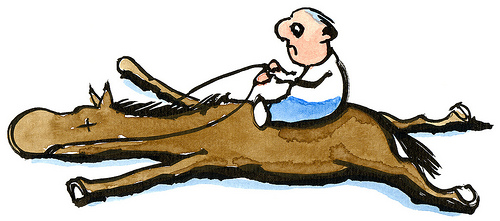
- Buying a stronger whip.
- Changing riders.
- Threatening the horse with termination.
- Appointing a committee to study the horse.
- Arranging to visit other countries to see how others ride dead horses.
- Lowering the standards so that dead horses can be included.
- Reclassifying the dead horse as “living impaired”.
- Hiring outside contractors to ride the dead horse.
- Harnessing several dead horses together to increase the speed.
- Providing additional funding and/or training to increase the dead horse’s performance.
- Doing a productivity study to see if lighter riders would improve the dead horse’s performance.
- Declaring that as the dead horse does not have to be fed, it is less costly, carries lower overhead, and therefore contributes substantially more to the bottom line of the economy than do some other horses.
- Rewriting the expected performance requirements on all horses.
- Promoting the dead horse to a supervisory position
As I read these strategies, I can picture many dead horses in my past (both people and products). They may also be partnered with some of the elephants in the room that no one is willing to talk about.
What dead horses are you riding?
